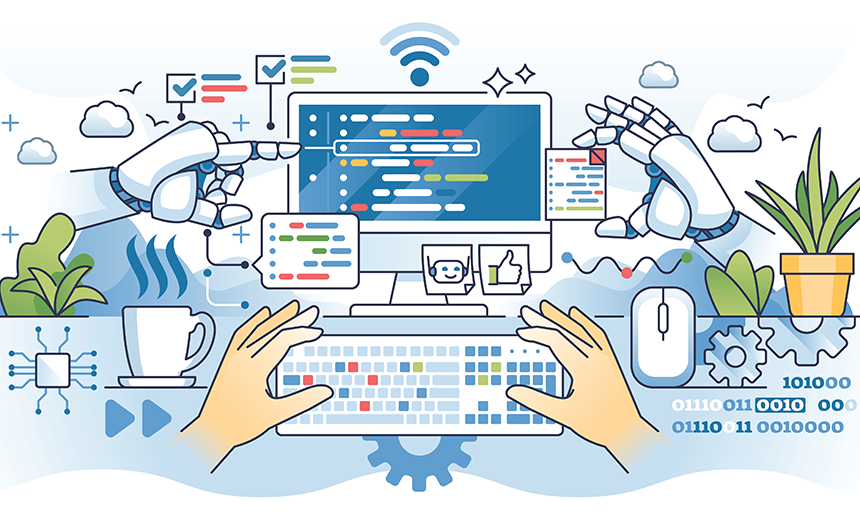Generative AI is no longer just a buzzword reserved for tech enthusiasts and cutting-edge startups. In today’s digital landscape, enterprise websites are rapidly adopting these powerful models to deliver elevated customer experiences, streamline content production, and boost operational efficiency. By leveraging natural language processing and machine learning, generative AI can help organizations craft personalized recommendations, automate customer interactions, and even predict user behaviors.
In this article, we explore ten of the most useful GenAI use cases for enterprise websites and demonstrate how forward-thinking businesses are tapping into the future of AI to stay ahead of the competition.
1. Conversational Chatbots and Virtual Assistants
What It Is
AI-driven chat interfaces that can handle customer queries, guide users through product catalogs, or even troubleshoot common issues in real time.
Why It Helps
- 24/7 Support: Provides immediate assistance at any time, reducing wait times.
- Personalized Responses: By integrating with user data (e.g., account details, purchase history), the chatbot can deliver context-aware support and upsell/cross-sell opportunities.
- Scalable & Cost-Effective: Alleviates the load on human customer service teams.
Example
A global insurance provider deploys a GenAI chatbot to answer FAQs about policy coverage and to help customers file claims more quickly.
2. Automated Content Generation and Copywriting
What It Is
AI tools that generate or draft marketing materials—such as website copy, blog posts, product descriptions, email campaigns, and social media posts.
Why It Helps
- Speed & Volume: Produces large volumes of content quickly, which marketing teams can refine.
- Consistency: Ensures a uniform brand voice across different channels.
- SEO Optimization: Can be trained or prompted to include SEO best practices and targeted keywords.
Example
An e-commerce site uses an LLM to draft product descriptions and blog posts, then the marketing team edits for style and final polish.
3. Dynamic Personalization and Product Recommendations
What It Is
Real-time recommendations for products, services, or content based on user behavior, preferences, and context—powered by AI models that analyze user data and website interactions.
Why It Helps
- Improved Engagement: Tailored suggestions encourage users to spend more time on the site.
- Higher Conversions: Personalized product recommendations can increase average order value and upsell opportunities.
- Customer Satisfaction: Users feel the site is more relevant to their needs and interests.
Example
A fashion retailer’s website tailors product recommendations by analyzing browsing history and style preferences in real time.
4. Intelligent Lead Qualification and Routing
What It Is
AI models embedded into contact forms or chat interfaces that analyze user inputs and predict sales-readiness, then route leads to the appropriate sales reps or marketing funnels.
Why It Helps
- Streamlined Process: Automates the initial screening of leads, freeing up sales teams to focus on high-potential prospects.
- Higher Efficiency: Reduces the time and resources spent on low-quality leads.
- Better User Experience: Qualified leads get faster, more focused follow-up, improving conversion rates.
Example
A B2B software company uses an LLM-based form to ask additional qualifying questions, then segments prospects automatically (e.g., by industry, budget size, or use case).
5. Multi-Language Support and Localization
What It Is
Generative AI that automatically translates and localizes website content, FAQs, and marketing materials into multiple languages, with cultural nuances intact.
Why It Helps
- Global Reach: Expands the addressable market by catering to non-English-speaking audiences.
- Consistency: Maintains brand messaging across different geographies.
- Cost Savings: Automates large portions of the translation workflow, reducing reliance on manual translation or third-party services.
Example
A SaaS platform deploys an AI-based translator to localize onboarding guides, ensuring new international users get a seamless experience in their native languages.
6. Knowledge Base Summaries and FAQ Generation
What It Is
AI models that read through extensive product documentation, manuals, or help-center articles and generate concise, user-friendly FAQs, summaries, and how-to guides.
Why It Helps
- Faster Support: Customers can quickly find relevant information without combing through lengthy documents.
- Better Documentation Quality: AI-driven summaries surface key points and highlight gaps or redundancies in existing documentation.
- Employee Efficiency: Internal teams spend less time rewriting or updating help articles from scratch.
Example
A technology firm uses an LLM to summarize long API documentation into quick-start guides for developers.
7. Real-Time Sentiment Analysis and Live Feedback Loops
What It Is
AI models monitor user interactions (e.g., chat or forum posts) and run sentiment analysis in real time. The website can adapt content or proactively offer assistance when negative sentiment is detected.
Why It Helps
- Proactive Customer Service: Quickly surface users who might be frustrated, allowing teams to intervene before issues escalate.
- Marketing Optimization: Gauge reactions to campaigns or product launches in real time, then dynamically adjust messaging or offers.
- Continuous Improvement: Feed insights back into product and content strategies to refine user experience.
Example
A subscription service tracks customer chat sentiments and automatically escalates unhappy customers to a human agent or offers targeted discounts to reduce churn.
8. Interactive Product/Service Advisors
What It Is
A step beyond basic chatbots, these AI-driven “advisors” ask questions about the customer’s requirements and preferences, then dynamically generate a personalized recommendation or solution path.
Why It Helps
- Guided Discovery: Reduces choice overload by narrowing options based on user input.
- Expert-Like Guidance: Mimics the experience of talking to a specialized consultant—helpful for complex or high-ticket items (e.g., insurance plans, enterprise software).
- Upsell & Cross-Sell: The advisor can propose complementary products or upgrades.
Example
A travel agency uses an AI advisor to create personalized travel itineraries based on the user’s budget, interests, and timeframe.
9. AI-Generated A/B Testing Variants
What It Is
- Using generative models to produce multiple versions of website copy, headlines, or layouts for A/B (or even multivariate) testing.
Why It Helps
- Speed & Scale: Quickly generates many variations, accelerating experimentation cycles.
- Creative Diversity: Provides fresh angles or writing styles that may not have been considered by human teams.
- Data-Driven Optimization: Continuously refine the site based on which variant resonates best with users.
Example
A media company tests AI-generated headlines for news articles to see which drives the highest click-through rates (CTR).
10. Automated Email and Chat Follow-Ups
What It Is
AI-generated follow-up emails or chat messages triggered after a specific user action, such as abandoning a shopping cart, filling out a lead form, or downloading a whitepaper.
Why It Helps
- Increased Conversions: Prompt, personalized follow-ups can bring users back into the funnel.
- Efficiency: Marketing and sales teams can automate routine follow-ups and focus on higher-value tasks.
- Personal Touch: AI can tailor messaging based on user data (purchase history, browsing behavior, location) to resonate more deeply.
Example
An e-learning platform sends personalized email nudges to students who pause their online courses, with content suggestions to re-engage them.
GenAI Implementation Considerations for Enterprise Websites
Data Integration
Connect GenAI solutions to CRM, ERP, and other back-office systems to provide users with real-time, personalized info (e.g., order status, user-specific offers).
Privacy and Compliance
Ensure compliance with data protection regulations (GDPR, CCPA, etc.). Use anonymized or tokenized data when training or fine-tuning LLMs.
Human-in-the-Loop
Keep humans available for complex queries or oversight. For example, when a chatbot can’t resolve an issue, escalate to a live agent. Also, use editorial reviews for automatically generated content (especially for regulated industries).
Model Maintenance
If using fine-tuned models, plan for periodic retraining as product lines, policies, or branding change. Regularly update knowledge bases for retrieval-augmented solutions so the AI has current data.
Prompt Engineering
Carefully craft prompts for each use case to ensure the AI stays on brand, adheres to compliance, and delivers the correct tone of voice.
Summary
Generative AI can fundamentally change how enterprises engage customers and market their products online. Whether it’s chatbots that deliver real-time support or personalized content that boosts conversions, GenAI offers scalable, cost-effective, and innovative ways to enhance marketing impact and customer satisfaction. With careful planning around data, compliance, and human oversight, these solutions can serve as a powerful extension of an enterprise’s digital presence.

 Ethan Vertal
Ethan Vertal




